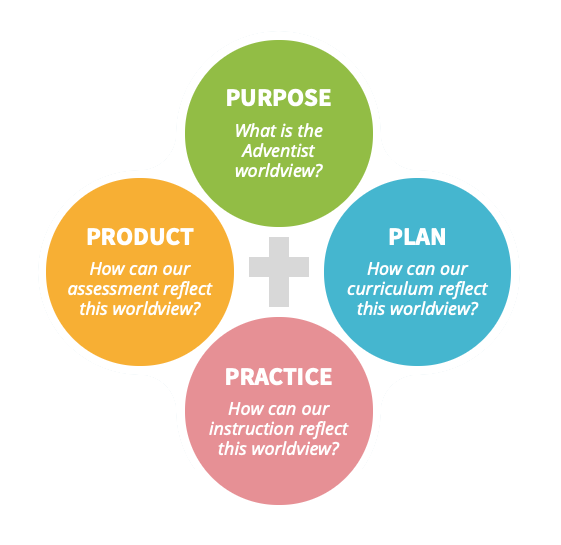
CORE CURRICULUM
Adventist curriculum development is defined by the Adventist worldview and based on our underlying philosophy. This Core process includes four overlapping stages: purpose, plan, practice, and product.
Purpose

A worldview serves as a conceptual tool or framework for perceiving and interpreting reality, which, in turn, informs the philosophy, mission/vision, and goals of an organization. The Adventist worldview accepts the Bible as the standard by which everything else is measured. Four key concepts (with accompanying essential questions) emerge from a biblical worldview that can be used as a lens for the Adventist curriculum development process.
Note how each quadrant in the Worldview, Curriculum, Instruction, and Assessment frameworks align to facilitate both horizontal and vertical planning.
Plan

Curriculum refers to the instructional components (essential questions, content/big ideas, skills, assessments, activities, and materials) of a particular course of study. Standards, what learners should know (content) and be able to do (skills), serve as the framework for curriculum development.
The curriculum model here incorporates these important components. Wiggins, McTighe, Erickson, and Hayes note the significance of essential questions. Essential questions provide a focus for inquiry, problem solving, application, and creativity which promote more active engagement of learners. Evidence from both national and international research also emphasizes that teaching and learning should be more concept-based; concepts link the content and skills in a meaningful way promoting greater understanding. Organizing the standards in relation to big ideas or concepts allows teachers and learners to “teach less, learn more.” Curriculum mapping is a process for aligning instructional components across an educational system or a classroom. A system-wide or core curriculum map describes agreed-upon internal and external standards, which should be addressed with consistency and flexibility by the teacher while developing units and lessons. Internal standards in NAD core curriculum maps reflect the Adventist worldview across K-12 curricula, while external standards reflect the integration of national and provincial/state standards.
Practice

Learners progress in many different ways. A natural, brain-friendly cycle of learning suggests that learners learn best when they can connect to personal experience (connect), develop a conceptual understanding (explain), practice and apply new knowledge (apply), and synthesize to create new ideas (extend). The instructional cycle above recognizes these elements of teaching and learning. It is based on consensus among various instructional models created by noted researchers, curriculum developers, and learning theorists, such as Gardner, Tomlinson, McCarthy, Johnson & Johnson, Hunter, Marzano, Wiggins, and McTighe. Models offered by these and other individuals include: Multiple Intelligences, Differentiated Instruction, Cooperative Learning, 4MAT, Inquiry Learning, Project-based Learning, and Understanding by Design. This model promotes teaching methods that meet the needs of individual learners and that ensure whole-person learning, all within the context of the Adventist worldview. Instruction focused on these four stages will appeal to all learners: those who enjoy talking about what’s happening in their lives, those who want more information about the topics being studied, those who want to know how the new concepts fit with real life, and those who want to creatively apply what they’ve learned to their own context in collaboration with others.
Product

Assessment is an integral part of the learning and teaching process which should be clearly aligned with the stated curriculum standards and the learning experiences. It should provide ongoing descriptive feedback that is clear, specific, meaningful, and timely. Reflective teachers use a variety of appropriate assessment practices to measure learner achievement and to inform instruction. The assessment cycle above offers a balanced emphasis on these assessment practices. Pre-assessment and summative assessment offer learners opportunity to creatively demonstrate their prior and newly acquired knowledge, respectively. Formative concept-based assessment and formative skill-based assessment include the use of a variety of ways for learners to demonstrate conceptual understanding and skill development. This model aligns with the work of Marzano, McCarthy, Wiggins, Stiggins, O’Connor, McTighe, and others. These four stages of assessment not only inform instruction but assist learners to develop self-assessment skills that enable them to assess their own learning, set specific goals, and plan next steps for their learning. The four core curriculum goals of Adventist education, informed by the Adventist worldview, can be consistently assessed as part of this cycle.
WANT TO KNOW MORE ABOUT OUR JOURNEY?
Sign up for a monthly email! News and updates delivered to your inbox.
